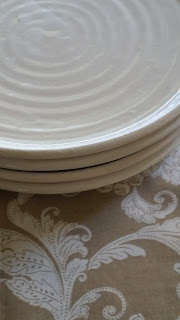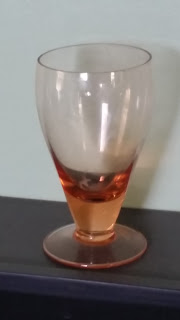This table was set with stoneware from one estate and linens from a different one. They couldn't be a more perfect match as the soft pink of the dishes is the same as the soft pink of the linens.
The napkins and tablecloth were the same fabric. There was a silver thread design running thru the napkin and a sheer silver runner down the center of the table.
The dishes had a mark on the back with an intricate, difficult to read font for the company name and Shadows and Japan more easily read. It is also poor picture quality, poor natural light as it was near dusk and a reflection obscures the company name. Oops. Kathryn has not been able to find this dish pattern when researching and I so far have been unsuccessful as well. It is felt that it was probably 1950s era.
The table included the serving pieces,
mismatched silver,
And two different crystal patterns.
Also included on the table was something that I have not seen before. A silver and crystal Victorian cruet set.
Kathryn, of New Leaf, shared that this piece would have been from the 1800s. Up until this estate she had never come across a complete set, and this estate contained a collection of four complete sets. Two sold at the estate sale and two were donated with the remainder of the estate. I did not take a picture of the second one but it is less ornate. Both contain all of their cruets. The patina of the silver and the etching on the cruets of this one is absolutely lovely.
All in all, it was an amazing vintage table.
Updated 10/16/16
In an interesting bit of timing, Susan at Between Naps on the Porch published a post with a tour of a historic home that included a photograph of a drawing of how a table would have been set in that era and smack dab in the middle of the table was a castor which apparently is another name for this Victorian piece. In reading about a castor there would have been bottles for salt and pepper, the stoppered bottles would have held oil and vinegar and perhaps soy sauce. There was usually a container with a hinged lid for mustard, and often one for castor sugar and one for spice. Some contained salt dips and perhaps a bell for the butler. According to my research they were patented in 1862 and by the early 1900s they were considered old fashioned and no longer widely used.I am joining Tablescape Thursday with Susan at BNOTP.















































